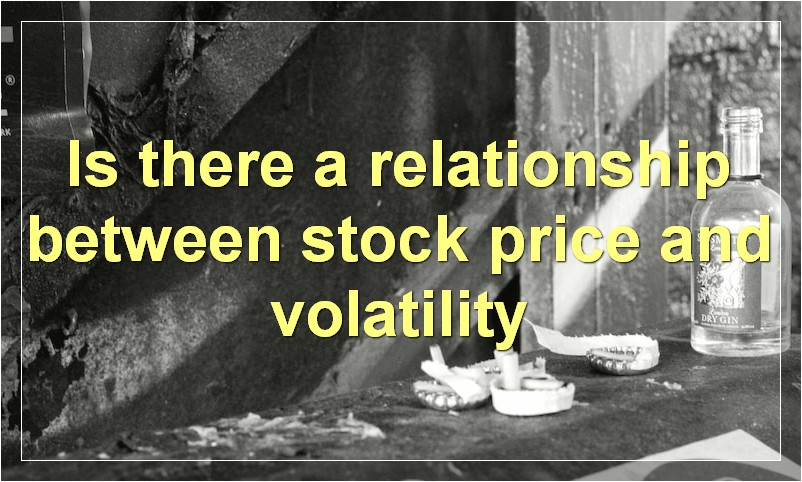In the stock market, volatility refers to the ups and downs of stock prices. Many investors see volatility as a risk. But if you understand how it works, you can use volatility to your advantage.
How do you calculate stock volatility
Volatility is a statistical measure of the dispersion of returns for a given security or market index. Volatility can either be measured by using the standard deviation or variance between returns from that same security or market index.
Why is volatility important?
Simply put, the higher the volatility, the riskier the investment. For example, let’s say you’re considering investing in Company A and Company B. Both companies have similar expected returns (meaning you think they will both make money). However, Company A has a lower volatility than Company B. This means that there is less risk associated with investing in Company A.
How do you calculate stock volatility?
There are a number of different ways to calculate stock volatility. The most common method is to use historical prices and calculate the standard deviation or variance. However, this only tells you about past volatility and may not be indicative of future risk.
What are some other methods for measuring volatility?
Some other methods for measuring volatility include: implied volatility, which uses options prices to infer the future level of volatility; and realised volatility, which uses actual traded prices to measure past volatility.
What factors can impact stock volatility?
A number of different factors can impact stock volatility, including: macroeconomic factors (such as interest rates and inflation); political factors (such as elections and international relations); and company-specific factors (such as financial stability and earnings).
What factors affect stock volatility

Volatility is a measure of how much the price of a security, like a stock, fluctuates. There are all sorts of things that can affect stock volatility, from political events to economic indicators. Here are just a few:
1. Company-specific news. If a company announces something big – good or bad – it can have an effect on its share price. This could be anything from a new product launch to a data breach.
2. The overall market. When the stock market is doing well, individual stocks tend to rise along with it. But when the market is down, stocks usually fall too.
3. The economy. Economic indicators like GDP growth, inflation, and unemployment can all affect stock prices. For example, if the economy is doing well, companies are likely to make more money and their stock prices will go up. But if the economy is struggling, stock prices usually fall.
4. Politics. Political events can also have an impact on stock prices. For example, if there’s a lot of uncertainty around an upcoming election, it could cause investors to sell off stocks in anticipation of a possible market downturn.
5. Natural disasters. Unfortunately, natural disasters like hurricanes and earthquakes can also lead to volatile stock prices. This is because when businesses are disrupted by a natural disaster, it can have a negative impact on their bottom line.
How can you use stock volatility to your advantage
When it comes to investing in stocks, there is a lot of talk about minimizing risk. However, many savvy investors know that there is always some degree of risk involved, no matter what you do. So rather than trying to avoid risk altogether, they focus on managing it. And one way to do that is by taking advantage of stock volatility.
Volatility simply refers to the ups and downs of the market. A volatile stock is one that tends to fluctuate a lot in price. While this may sound like a bad thing, it can actually be an opportunity for investors.
For example, let’s say you buy a stock for $100 and it goes down to $90. This 10% drop may be considered volatile. But if you believe in the long-term prospects of the company, you might view this as a buying opportunity. After all, the stock is now on sale for 10% off!
Of course, there is always the potential that the stock could continue to fall. But if you have done your research and believe in the company, then you may be willing to take on that risk.
Investors can also use volatility to their advantage when it comes to selling stocks. Let’s say you own a stock that has gone up 20% over the past year. If it starts to become volatile and fluctuates up and down 5-10%, you may consider selling it. By selling at this point, you lock in your gains and avoid the potential for losses if the stock were to continue falling.
So while stock volatility can be unsettling, it can also create opportunities for savvy investors. By understanding how to use it to your advantage, you can help manage risk and improve your chances of success in the stock market.
What is the historical volatility of a stock
Volatility is a measure of how much the price of a security, derivative, or other financial asset fluctuates. It is measured by calculating the standard deviation of the annualized returns over a given period of time. The historical volatility of a stock is a measure of how much the stock’s price has fluctuated over time.
How do you measure stock volatility
Volatility is a measure of how much the price of a stock fluctuates. It’s calculated by taking the standard deviation of the stock’s daily closing prices over a certain period of time, usually 20 days.
Volatility can be used to measure risk, since big swings in stock prices can lead to losses. But it can also be used to find opportunities, since stocks that are volatile often move in big directions and can provide good profits for investors who know how to handle them.
There are a number of ways to measure stock volatility, but the most common is probably the beta coefficient. Beta measures how much a stock’s price moves in relation to the overall market. A stock with a beta of 1.5 will move 1.5 times as much as the market does. So if the market goes up 10%, a stock with a beta of 1.5 will go up 15%.
A high beta means a stock is more volatile than the market, while a low beta means it’s less volatile. Some investors like to buy stocks with high betas, expecting them to make bigger gains when the market is doing well. Others prefer low-beta stocks, which they think will hold up better when the market is going down.
Is there a relationship between stock price and volatility

Is there a relationship between stock price and volatility?
The answer is yes, there is definitely a relationship between stock price and volatility. When stock prices are volatile, it means that they are subject to large swings in price. This can be caused by a number of factors, including economic news, changes in the market, or even rumors. Volatility can be a good thing or a bad thing, depending on how you look at it. For investors, volatility can be an opportunity to make quick profits. However, it can also lead to losses just as quickly. That’s why it’s important to understand the relationship between stock price and volatility before making any investment decisions.
What is the difference between implied and historical volatility
Volatility is a measure of how much the price of an asset, such as a stock, commodity or currency, fluctuates over time. Implied volatility is a measure of how much the market thinks the price of an asset will fluctuate in the future, while historical volatility is a measure of how much the price of an asset has actually fluctuated over a certain period of time.
There are a number of ways to measure volatility, but one of the most common is to calculate the standard deviation of the asset’s return. The higher the standard deviation, the more volatile the asset.
Implied volatility is typically measured using options prices. This is because options prices contain information about how much the market thinks the underlying asset will move in the future. Historical volatility can be measured using data on past price movements.
The main difference between implied and historical volatility is that implied volatility is forward-looking, while historical volatility is backward-looking. This means that implied volatility reflects the market’s expectations for future price movements, while historical volatility simply measures how much an asset has fluctuated in the past.
Both implied and historical volatility can be useful measures when trying to predict future price movements. However, it’s important to remember that they are not perfect predictors, and there is always some degree of uncertainty when it comes to forecasting market behavior.
How can you use options to hedge against stock volatility
Volatility is a measure of how much the price of a security, such as a stock, fluctuates. A stock with higher volatility is more risky, but can also offer higher returns. You can use options to hedge against stock volatility by buying put options. Put options give you the right to sell a stock at a certain price, so if the stock price falls, you can sell it at the strike price and make a profit.
What is the VIX, and how can it be used to measure stock market volatility
The VIX, which stands for the CBOE Volatility Index, is a measurement of stock market volatility. It is calculated by taking the weighted average of the prices of put and call options on the S&P 500 index. The VIX is often referred to as the “fear index” because it tends to rise when stock prices are falling and investors are feeling anxious about the market.
One way to use the VIX is to measure the level of fear in the market. If the VIX is high, it means that investors are expecting a lot of volatility in the stock market and they are worried about a potential drop in prices. Conversely, if the VIX is low, it means that investors are relatively calm and they don’t expect much movement in the market.
Another way to use the VIX is to predict future stock market volatility. Generally speaking, if the VIX is high, it means that volatility is likely to continue in the future. And if the VIX is low, it means that volatility is likely to subside. Of course, there are no guarantees when it comes to predicting the stock market, but the VIX can be a helpful tool for gauging investor sentiment and making investment decisions.
What are some strategies for trading stocks with high volatility
There are a number of strategies that traders can use when trading stocks with high volatility. Some common strategies include buying on dips, selling on rallies, and using stop-loss orders.
Many traders also prefer to trade stocks with high volatility using technical analysis. This involves looking at charts to identify patterns that can give an indication of future price movements.
Another important consideration when trading stocks with high volatility is risk management. This means setting strict limits on how much money you are willing to lose on any one trade. It is also important to have a plan for exits so that you can limit your losses if the market moves against you.

